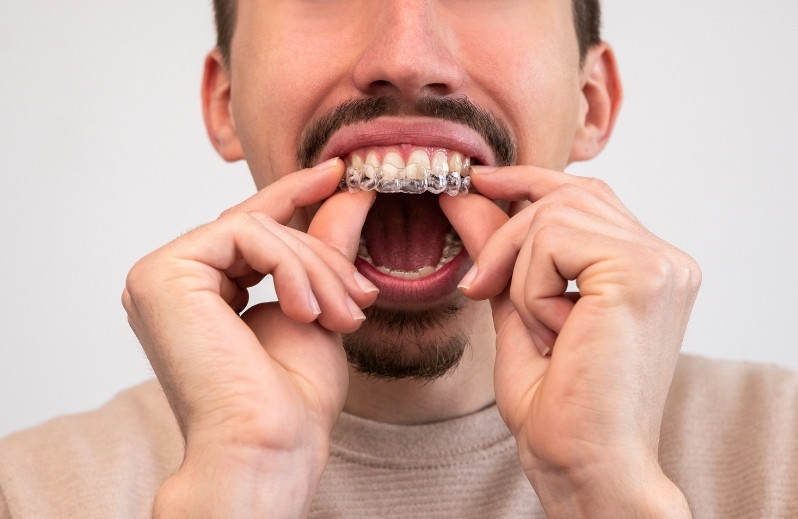Enquiry
Call Center:
+919355333956
Managing Discomfort During Invisalign Treatment
Invisalign is a popular orthodontic treatment that gradually shifts teeth using a series of clear aligners. While it offers a comfortable alternative to traditional metal braces, mild discomfort can occur as the mouth adjusts to the aligner trays. This temporary discomfort is a normal straightening process and usually decreases over time.
Understanding how to manage Invisalign-related pain can make the treatment more comfortable. Simple adjustments, such as using Invisalign pain relief strategies and maintaining good oral hygiene, can help ease Invisalign pain. Patients can confidently continue their Invisalign journey by knowing what to expect and how to minimise discomfort

How Can Invisalign Cause You Discomfort?
The slight discomfort that comes with Invisalign is actually a sign that your aligners are doing their job! Understand why this happens:
- Gentle Pressure on Teeth—Each new set of aligners slowly shifts your teeth, which may cause an ache for a couple of days.
- Aligner Edges Affecting the Gums – The edges of your trays will be uncomfortable at first, but your mouth will adapt to them over time.
- Mild Speech Changes – Some individuals have a temporary lisp or increased saliva flow as their tongue adjusts to the aligners.
While these sensations are common, they shouldn’t be painful or unbearable. If you’re feeling uncomfortable, the tips below will help, or you can consult a dentist at The dental port.
Managing Invisalign Discomfort
Adjusting to Invisalign aligners can cause initial discomfort, but there are ways to make the process easier. Simple techniques can help reduce Invisalign jaw pain and alleviate discomfort, allowing patients to continue their treatment with minimal disruption.
While mild soreness is common initially, the right approach can prevent unnecessary discomfort and keep the experience as smooth as possible.
Tips for a Comfortable Treatment
Simple strategies can help manage discomfort and make Invisalign treatment more comfortable.
- Use an ice pack or cold compress:
Applying a cold compress to the outside of the mouth can provide temporary relief and reduce swelling caused by pressure on your teeth. - Drink cold water:
Sipping cold water throughout the day can help counter pain and soothe gum irritation. - Suck on ice cubes:
This can ease Invisalign jaw pain and provide relief from tooth pain without interfering with the aligners. - Avoid eating hard, crunchy foods:
Soft foods are easier to chew and reduce the risk of causing discomfort while wearing Invisalign aligners. - Use over-the-counter pain relievers:
If the pain persists, a mild pain reliever can help manage it and prevent it from recurring. - Maintain proper oral hygiene:
Good oral health can prevent gum irritation and other issues that may worsen Invisalign-related pain. - Stay consistent with aligner wear:
Wearing aligners as instructed helps teeth gradually shift, reducing the likelihood of severe pain from unnecessary delays. - Be mindful of allergic reactions:
While rare, some people may experience irritation from Invisalign trays. If this happens, seeking professional advice is essential.
These strategies can help patients avoid Invisalign pain and support a successful treatment. Effectively managing discomfort allows for a straighter smile without unnecessary pain.

Guide for a Smooth Treatment
Simple habits can improve aligner comfort and help avoid unnecessary pain.
- Check that aligners fit properly:
A secure fit helps prevent discomfort and allows teeth to move as expected, reducing issues with misaligned teeth. - Limit how often aligners are removed:
Taking aligners out too frequently can cause unnecessary discomfort and slow progress. - Start new aligners before bed:
Wearing a new set overnight allows teeth to adjust during sleep, reducing gum pain in the initial stages. - Follow the prescribed schedule:
Sticking to the treatment plan helps prevent persistent discomfort and supports steady tooth movement. - Maintain good oral hygiene:
Regular brushing and flossing prevent plaque buildup, leading to gum irritation and affecting dental health. - Keep aligners clean:
Rinsing and brushing aligners daily prevents bacteria buildup, improving overall comfort.
Following these steps helps alleviate Invisalign discomfort and makes the process smoother
Preventing Soft Tissue Irritation
Wearing invisible aligners can sometimes irritate the gums, cheeks, or tongue, especially during the early stages of treatment. This discomfort is usually temporary as the mouth adjusts to the aligners.
However, sharp edges or friction from dental aligners may lead to sore spots or minor irritation. Taking simple steps can help prevent and manage these issues.
- Use orthodontic wax:
Applying orthodontic wax to rough or sharp edges can reduce irritation and prevent further discomfort. - Avoid hard, crunchy foods:
Eating softer foods reduces friction and helps prevent unnecessary irritation inside the mouth. - Rinse with salt water:
A warm saltwater rinse can help soothe sore areas and promote healing. - Stay hydrated:
Drinking plenty of water keeps the mouth moist and reduces dryness that can contribute to irritation. - Maintain proper oral hygiene:
Brushing and flossing regularly helps keep gums healthy and reduces the risk of further discomfort.
By managing irritation early, patients can adjust to their INVISALIGN TREATMENT more comfortably.
Invisalign provides a discreet and comfortable way to straighten teeth. However, some mild discomfort is expected as teeth gradually shift.
Knowing how to manage discomfort can make the treatment experience much more manageable. Simple adjustments, such as using a cold compress, maintaining good oral hygiene, and making mindful food choices, can help alleviate Invisalign discomfort.
Most discomfort fades as the mouth adjusts. However, persistent irritation or pain may require professional attention. Staying consistent with aligner wear and following recommended care practices can help keep the process on track.
For those needing guidance on Invisalign pain management, THE DENTAL PORT offers support. Their team provides personalised advice to help patients throughout their Invisalign journey.
- Invisalign Treatment in Noida Sector 132
- Invisalign Treatment in Noida Sector 135
- Invisalign Treatment in Noida Sector 168
- Invisalign Treatment in Noida Sector 143
Tags : Invisalign Treatment in Noida Sector 128, Invisalign Treatment in Noida Sector 93A, Invisalign Treatment in Noida Sector 137 , Invisalign Treatment in Noida Sector 110, Invisalign Treatment in Noida Sector 150, Invisalign Treatment in Noida Sector 104






 Call Or Whatsapp Now
Call Or Whatsapp Now